Russia — Wikipedia
Country in Northern Asia and Eastern Europe
Coordinates: 60°N 90°E / 60°N 90°E / 60; 90
Russia (Russian: Росси́я, tr. Rossiya, IPA: [rɐˈsʲijə]), officially the Russian Federation[12] (Russian: Росси́йская Федера́ция, tr. Rossiyskaya Federatsiya, IPA: [rɐˈsʲijskəjə fʲɪdʲɪˈratsɨjə]), is a transcontinental country in Eastern Europe and North Asia.[13] At 17,125,200 square kilometres (6,612,100 sq mi),[14] it is, by a considerable margin, the largest country in the world by area, covering more than one-eighth of the Earth’s inhabited land area,[15][16][17] and the ninth most populous, with about 146.79 million people as of 2019[update], including Crimea.[8] About 77% of the population live in the western, European part of the country. Russia’s capital, Moscow, is one of the largest cities in the world and the largest city in Europe; other major cities include Saint Petersburg, Novosibirsk, Yekaterinburg and Nizhny Novgorod. Extending across the entirety of Northern Asia and much of Eastern Europe, Russia spans eleven time zones and incorporates a wide range of environments and landforms. From northwest to southeast, Russia shares land borders with Norway, Finland, Estonia, Latvia, Lithuania and Poland (both with Kaliningrad Oblast), Belarus, Ukraine, Georgia, Azerbaijan, Kazakhstan, China, Mongolia and North Korea. It shares maritime borders with Japan by the Sea of Okhotsk and the U.S. state of Alaska across the Bering Strait. However, Russia recognises two more countries that border it, Abkhazia and South Ossetia, both of which are internationally recognized as parts of Georgia.
The East Slavs emerged as a recognizable group in Europe between the 3rd and 8th centuries AD. [18] Founded and ruled by a Varangian warrior elite and their descendants, the medieval state of Rus arose in the 9th century. In 988 it adopted Orthodox Christianity from the Byzantine Empire,[19] beginning the synthesis of Byzantine and Slavic cultures that defined Russian culture for the next millennium.[19] Rus ultimately disintegrated into a number of smaller states; most of the Rus’ lands were overrun by the Mongol invasion and became tributaries of the nomadic Golden Horde in the 13th century.[20] The Grand Duchy of Moscow gradually reunified the surrounding Russian principalities and won independence from the Golden Horde by defeating them at Great Stand on the Ugra River in 1480. By the 18th century, the nation had greatly expanded through conquest, annexation, and exploration to become the Russian Empire, which was the third largest empire in history, stretching from Poland on the west to Alaska on the east.[21]
Following the Russian Revolution, the Russian Soviet Federative Socialist Republic became the largest and leading constituent of the Union of Soviet Socialist Republics, the world’s first constitutionally socialist state.[23] The Soviet Union played a decisive role in the Allied victory in World War II,[24][25] and emerged as a recognized superpower and rival to the United States during the Cold War. The Soviet era saw some of the most significant technological achievements of the 20th century, including the world’s first human-made satellite and the launching of the first humans in space. By the end of 1990, the Soviet Union had the world’s second largest economy, largest standing military in the world and the largest stockpile of weapons of mass destruction.[26][27][28] Following the dissolution of the Soviet Union in 1991, twelve independent republics emerged from the USSR: Russia, Ukraine, Belarus, Kazakhstan, Uzbekistan, Armenia, Azerbaijan, Georgia, Kyrgyzstan, Moldova, Tajikistan, Turkmenistan and the Baltic states regained independence: Estonia, Latvia, Lithuania; the Russian SFSR reconstituted itself as the Russian Federation and is recognized as the continuing legal personality and a successor of the Soviet Union. [29]
The political system of Russia is governed as a federal semi-presidential republic since 1993. Under Vladimir Putin’s rule since 2012, and from 2000–2008, Russia has been criticized by a number of human rights groups, outside observers and political dissidents for its authoritarian rule, poor human rights record, sham elections, imperialistic foreign policy in Syria, Georgia and Ukraine, alleged interference in the 2016 American elections and repression of its LGBT population.[30][31][32] Putin’s annexation of Crimea in 2014 led to international sanctions,[33][34][35] which Russia responded to with sanctions against a number of countries, including a total ban on food imports from the United States.
Russia’s economy ranks as the eleventh largest by nominal GDP and sixth largest by purchasing power parity in 2019.[40] Russia’s extensive mineral and energy resources are the largest such reserves in the world,[41] making it one of the leading producers of oil and natural gas globally.[42][43] The country is one of the five recognized nuclear weapons states and possesses the largest stockpile of weapons of mass destruction.[44] Russia is a great power as well as a regional power and has been characterised as a potential superpower. It is a permanent member of the United Nations Security Council and an active global partner of ASEAN, [45][46][47] as well as a member of the Shanghai Cooperation Organisation (SCO), the G20, the Council of Europe, the Asia-Pacific Economic Cooperation (APEC), the Organization for Security and Co-operation in Europe (OSCE), the International Investment Bank (IIB) and the World Trade Organization (WTO), as well as being the leading member of the Commonwealth of Independent States (CIS), the Collective Security Treaty Organization (CSTO) and one of the five members of the Eurasian Economic Union (EEU), along with Armenia, Belarus, Kazakhstan and Kyrgyzstan.
Etymology
The name Russia is derived from Rus’, a medieval state populated mostly by the East Slavs. However, this proper name became more prominent in the later history, and the country typically was called by its inhabitants «Русская Земля» (russkaja zemlja), which can be translated as «Russian Land» or «Land of Rus'». In order to distinguish this state from other states derived from it, it is denoted as
An old Latin version of the name Rus’ was Ruthenia, mostly applied to the western and southern regions of Rus’ that were adjacent to Catholic Europe. The current name of the country, Россия (Rossija), comes from the Byzantine Greek designation of the Rus’, Ρωσσία Rossía—spelled Ρωσία (Rosía pronounced [roˈsia]) in Modern Greek.[50]
The standard way to refer to citizens of Russia is «Russians» in English[51] and rossiyane (Russian: россияне) in Russian. There are two Russian words which are commonly translated into English as «Russians». One is «русские» ( russkiye), which most often means «ethnic Russians». Another is «россияне» (rossiyane), which means «citizens of Russia, regardless of ethnicity». Translations into other languages often do not distinguish these two groups.
History
Early history
Nomadic pastoralism developed in the Pontic-Caspian steppe beginning in the Chalcolithic.[52]
In classical antiquity, the Pontic Steppe was known as Scythia. Beginning in the 8th century BC, Ancient Greek traders brought their civilization to the trade emporiums in Tanais and Phanagoria. Ancient Greek explorers, most notably Pytheas, even went as far as modern day Kaliningrad, on the Baltic Sea. Romans settled on the western part of the Caspian Sea, where their empire stretched towards the east.[dubious – discuss][53] In the 3rd to 4th centuries AD a semi-legendary Gothic kingdom of Oium existed in Southern Russia until it was overrun by Huns. Between the 3rd and 6th centuries AD, the Bosporan Kingdom, a Hellenistic polity which succeeded the Greek colonies,
The ancestors of modern Russians are the Slavic tribes, whose original home is thought by some scholars to have been the wooded areas of the Pinsk Marshes.[57] The East Slavs gradually settled Western Russia in two waves: one moving from Kiev toward present-day Suzdal and Murom and another from Polotsk toward Novgorod and Rostov. From the 7th century onwards, the East Slavs constituted the bulk of the population in Western Russia[58] and assimilated the native Finno-Ugric peoples, including the Merya, the Muromians, and the Meshchera.
Kievan Rus’
 Kievan Rus’ in the 11th century
Kievan Rus’ in the 11th centuryThe establishment of the first East Slavic states in the 9th century coincided with the arrival of Varangians, the traders, warriors and settlers from the Baltic Sea region. Primarily they were Vikings of Scandinavian origin, who ventured along the waterways extending from the eastern Baltic to the Black and Caspian Seas.[59] According to the Primary Chronicle, a Varangian from Rus’ people, named Rurik, was elected ruler of Novgorod in 862. In 882, his successor Oleg ventured south and conquered Kiev,[60] which had been previously paying tribute to the Khazars. Oleg, Rurik’s son Igor and Igor’s son Sviatoslav subsequently subdued all local East Slavic tribes to Kievan rule, destroyed the Khazar khaganate and launched several military expeditions to Byzantium and Persia.
In the 10th to 11th centuries Kievan Rus’ became one of the largest and most prosperous states in Europe.
In the 11th and 12th centuries, constant incursions by nomadic Turkic tribes, such as the Kipchaks and the Pechenegs, caused a massive migration of Slavic populations to the safer, heavily forested regions of the north, particularly to the area known as Zalesye.[62]
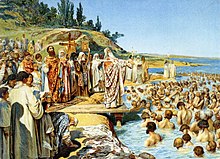
The age of feudalism and decentralization was marked by constant in-fighting between members of the Rurik Dynasty that ruled Kievan Rus’ collectively. Kiev’s dominance waned, to the benefit of Vladimir-Suzdal in the north-east, Novgorod Republic in the north-west and Galicia-Volhynia in the south-west.
Ultimately Kievan Rus’ disintegrated, with the final blow being the Mongol invasion of 1237–40[63] that resulted in the destruction of Kiev[64] and the death of about half the population of Rus’.[65] The invading Mongol elite, together with their conquered Turkic subjects (Cumans, Kipchaks, Bulgars), became known as Tatars, forming the state of the Golden Horde, which pillaged the Russian principalities; the Mongols ruled the Cuman-Kipchak confederation and Volga Bulgaria (modern-day southern and central expanses of Russia) for over two centuries.[66]
Galicia-Volhynia was eventually assimilated by the Kingdom of Poland, while the Mongol-dominated Vladimir-Suzdal and Novgorod Republic, two regions on the periphery of Kiev, established the basis for the modern Russian nation.[19] The Novgorod together with Pskov retained some degree of autonomy during the time of the Mongol yoke and were largely spared the atrocities that affected the rest of the country. Led by Prince Alexander Nevsky, Novgorodians repelled the invading Swedes in the Battle of the Neva in 1240, as well as the Germanic crusaders in the Battle of the Ice in 1242, breaking their attempts to colonize the Northern Rus’.
Grand Duchy of Moscow
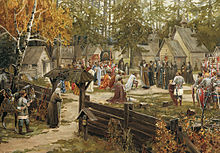
The most powerful state to eventually arise after the destruction of Kievan Rus’ was the Grand Duchy of Moscow («Muscovy» in the Western chronicles), initially a part of Vladimir-Suzdal. While still under the domain of the Mongol-Tatars and with their connivance, Moscow began to assert its influence in the Central Rus’ in the early 14th century, gradually becoming the leading force in the process of the Rus’ lands’ reunification and expansion of Russia.[67] Moscow’s last rival, the Novgorod Republic, prospered as the chief fur trade center and the easternmost port of the Hanseatic League.
Times remained difficult, with frequent Mongol-Tatar raids. Agriculture suffered from the beginning of the Little Ice Age. As in the rest of Europe, plague was a frequent occurrence between 1350 and 1490.[68] However, because of the lower population density and better hygiene—widespread practicing of banya, a wet steam bath—the death rate from plague was not as severe as in Western Europe,[69] and population numbers recovered by 1500.[68]
Led by Prince Dmitry Donskoy of Moscow and helped by the Russian Orthodox Church, the united army of Russian principalities inflicted a milestone defeat on the Mongol-Tatars in the Battle of Kulikovo in 1380. Moscow gradually absorbed the surrounding principalities, including formerly strong rivals such as Tver and Novgorod.
Ivan III («the Great») finally threw off the control of the Golden Horde and consolidated the whole of Central and Northern Rus’ under Moscow’s dominion. He was also the first to take the title «Grand Duke of all the Russias».[70] After the fall of Constantinople in 1453, Moscow claimed succession to the legacy of the Eastern Roman Empire. Ivan III married Sophia Palaiologina, the niece of the last Byzantine emperor Constantine XI, and made the Byzantine double-headed eagle his own, and eventually Russia’s, coat-of-arms.
Tsardom of Russia
In development of the Third Rome ideas, the Grand Duke Ivan IV (the «Terrible»)[71] was officially crowned first Tsar («Caesar») of Russia in 1547. The Tsar promulgated a new code of laws (Sudebnik of 1550), established the first Russian feudal representative body (Zemsky Sobor) and introduced local self-management into the rural regions.[72][73]

During his long reign, Ivan the Terrible nearly doubled the already large Russian territory by annexing the three Tatar khanates (parts of the disintegrated Golden Horde): Kazan and Astrakhan along the Volga River, and the Siberian Khanate in southwestern Siberia. Thus, by the end of the 16th century Russia was transformed into a multiethnic, multidenominational and transcontinental state.
However, the Tsardom was weakened by the long and unsuccessful Livonian War against the coalition of Poland, Lithuania, and Sweden for access to the Baltic coast and sea trade.[74] At the same time, the Tatars of the Crimean Khanate, the only remaining successor to the Golden Horde, continued to raid Southern Russia.[75] In an effort to restore the Volga khanates, Crimeans and their Ottoman allies invaded central Russia and were even able to burn down parts of Moscow in 1571.[76] But in the next year the large invading army was thoroughly defeated by Russians in the Battle of Molodi, forever eliminating the threat of an Ottoman–Crimean expansion into Russia. The slave raids of Crimeans, however, did not cease until the late 17th century though the construction of new fortification lines across Southern Russia, such as the Great Abatis Line, constantly narrowed the area accessible to incursions.[77]

The death of Ivan’s sons marked the end of the ancient Rurik Dynasty in 1598, and in combination with the famine of 1601–03[78] led to civil war, the rule of pretenders, and foreign intervention during the Time of Troubles in the early 17th century.[79] The Polish–Lithuanian Commonwealth occupied parts of Russia, including Moscow. In 1612, the Poles were forced to retreat by the Russian volunteer corps, led by two national heroes, merchant Kuzma Minin and Prince Dmitry Pozharsky. The Romanov Dynasty acceded to the throne in 1613 by the decision of Zemsky Sobor, and the country started its gradual recovery from the crisis.
Russia continued its territorial growth through the 17th century, which was the age of Cossacks. Cossacks were warriors organized into military communities, resembling pirates and pioneers of the New World. In 1648, the peasants of Ukraine joined the Zaporozhian Cossacks in rebellion against Poland-Lithuania during the Khmelnytsky Uprising in reaction to the social and religious oppression they had been suffering under Polish rule. In 1654, the Ukrainian leader, Bohdan Khmelnytsky, offered to place Ukraine under the protection of the Russian Tsar, Aleksey I. Aleksey’s acceptance of this offer led to another Russo-Polish War. Finally, Ukraine was split along the Dnieper River, leaving the western part, right-bank Ukraine, under Polish rule and the eastern part (Left-bank Ukraine and Kiev) under Russian rule. Later, in 1670–71, the Don Cossacks led by Stenka Razin initiated a major uprising in the Volga Region, but the Tsar’s troops were successful in defeating the rebels.
In the east, the rapid Russian exploration and colonisation of the huge territories of Siberia was led mostly by Cossacks hunting for valuable furs and ivory. Russian explorers pushed eastward primarily along the Siberian River Routes, and by the mid-17th century there were Russian settlements in Eastern Siberia, on the Chukchi Peninsula, along the Amur River, and on the Pacific coast. In 1648, the Bering Strait between Asia and North America was passed for the first time by Fedot Popov and Semyon Dezhnyov.
Imperial Russia

Under Peter the Great, Russia was proclaimed an Empire in 1721 and became recognized as a world power. Ruling from 1682 to 1725, Peter defeated Sweden in the Great Northern War, forcing it to cede West Karelia and Ingria (two regions lost by Russia in the Time of Troubles),[80] as well as Estland and Livland, securing Russia’s access to the sea and sea trade.[81] On the Baltic Sea, Peter founded a new capital called Saint Petersburg, later known as Russia’s «window to Europe». Peter the Great’s reforms brought considerable Western European cultural influences to Russia.
The reign of Peter I’s daughter Elizabeth in 1741–62 saw Russia’s participation in the Seven Years’ War (1756–63). During this conflict Russia annexed East Prussia for a while and even took Berlin. However, upon Elizabeth’s death, all these conquests were returned to the Kingdom of Prussia by pro-Prussian Peter III of Russia.
Catherine II («the Great»), who ruled in 1762–96, presided over the Age of Russian Enlightenment. She extended Russian political control over the Polish-Lithuanian Commonwealth and incorporated most of its territories into Russia during the Partitions of Poland, pushing the Russian frontier westward into Central Europe. In the south, after successful Russo-Turkish Wars against Ottoman Turkey, Catherine advanced Russia’s boundary to the Black Sea, defeating the Crimean Khanate. As a result of victories over Qajar Iran through the Russo-Persian Wars, by the first half of the 19th century Russia also made significant territorial gains in Transcaucasia and the North Caucasus, forcing the former to irrevocably cede what is nowadays Georgia, Dagestan, Azerbaijan and Armenia to Russia.[82][83] This continued with Alexander I’s (1801–25) wresting of Finland from the weakened kingdom of Sweden in 1809 and of Bessarabia from the Ottomans in 1812. At the same time, Russians colonized Alaska and even founded settlements in California, such as Fort Ross.
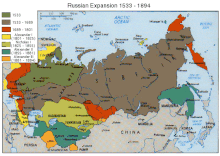 Russian expansion in Eurasia between 1533 and 1894
Russian expansion in Eurasia between 1533 and 1894In 1803–1806, the first Russian circumnavigation was made, later followed by other notable Russian sea exploration voyages. In 1820, a Russian expedition discovered the continent of Antarctica.
In alliances with various European countries, Russia fought against Napoleon’s France. The French invasion of Russia at the height of Napoleon’s power in 1812 reached Moscow, but eventually failed miserably as the obstinate resistance in combination with the bitterly cold Russian winter led to a disastrous defeat of invaders, in which more than 95% of the pan-European Grande Armée perished.[84] Led by Mikhail Kutuzov and Barclay de Tolly, the Russian army ousted Napoleon from the country and drove through Europe in the war of the Sixth Coalition, finally entering Paris. Alexander I headed Russia’s delegation at the Congress of Vienna that defined the map of post-Napoleonic Europe.
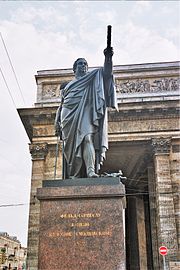
The officers of the Napoleonic Wars brought ideas of liberalism back to Russia with them and attempted to curtail the tsar’s powers during the abortive Decembrist revolt of 1825. At the end of the conservative reign of Nicolas I (1825–55), a zenith period of Russia’s power and influence in Europe was disrupted by defeat in the Crimean War. Between 1847 and 1851, about one million people died of Asiatic cholera.[85]
Nicholas’s successor Alexander II (1855–81) enacted significant changes in the country, including the emancipation reform of 1861. These Great Reforms spurred industrialization and modernized the Russian army, which had successfully liberated Bulgaria from Ottoman rule in the 1877–78 Russo-Turkish War.
The late 19th century saw the rise of various socialist movements in Russia. Alexander II was killed in 1881 by revolutionary terrorists, and the reign of his son Alexander III (1881–94) was less liberal but more peaceful. The last Russian Emperor, Nicholas II (1894–1917), was unable to prevent the events of the Russian Revolution of 1905, triggered by the unsuccessful Russo-Japanese War and the demonstration incident known as Bloody Sunday. The uprising was put down, but the government was forced to concede major reforms (Russian Constitution of 1906), including granting the freedoms of speech and assembly, the legalization of political parties, and the creation of an elected legislative body, the State Duma of the Russian Empire. The Stolypin agrarian reform led to a massive peasant migration and settlement into Siberia. More than four million settlers arrived in that region between 1906 and 1914.[86]
February Revolution and Russian Republic

In 1914, Russia entered World War I in response to Austria-Hungary’s declaration of war on Russia’s ally Serbia, and fought across multiple fronts while isolated from its Triple Entente allies. In 1916, the Brusilov Offensive of the Russian Army almost completely destroyed the military of Austria-Hungary. However, the already-existing public distrust of the regime was deepened by the rising costs of war, high casualties, and rumors of corruption and treason. All this formed the climate for the Russian Revolution of 1917, carried out in two major acts.
The February Revolution forced Nicholas II to abdicate; he and his family were imprisoned and later executed in Yekaterinburg during the Russian Civil War. The monarchy was replaced by a shaky coalition of political parties that declared itself the Provisional Government. On 1 September (14), 1917, upon a decree of the Provisional Government, the Russian Republic was proclaimed.[87] On 6 January (19), 1918, the Russian Constituent Assembly declared Russia a democratic federal republic (thus ratifying the Provisional Government’s decision). The next day the Constituent Assembly was dissolved by the All-Russian Central Executive Committee.
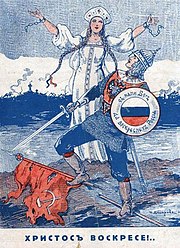
Soviet Russia and civil war
An alternative socialist establishment co-existed, the Petrograd Soviet, wielding power through the democratically elected councils of workers and peasants, called Soviets. The rule of the new authorities only aggravated the crisis in the country, instead of resolving it. Eventually, the October Revolution, led by Bolshevik leader Vladimir Lenin, overthrew the Provisional Government and gave full governing power to the Soviets, leading to the creation of the world’s first socialist state.
Following the October Revolution, a civil war broke out between the anti-Communist White movement and the new Soviet regime with its Red Army. Bolshevist Russia lost its Ukrainian, Polish, Baltic, and Finnish territories by signing the Treaty of Brest-Litovsk that concluded hostilities with the Central Powers of World War I. The Allied powers launched an unsuccessful military intervention in support of anti-Communist forces. In the meantime both the Bolsheviks and White movement carried out campaigns of deportations and executions against each other, known respectively as the Red Terror and White Terror. By the end of the civil war, Russia’s economy and infrastructure were heavily damaged. There were an estimated 7–12 million casualties during the war, mostly civilians.[88] Millions became White émigrés,[89] and the Russian famine of 1921–22 claimed up to five million victims.[90]
Soviet Union

The Russian Soviet Federative Socialist Republic (called Russian Socialist Federative Soviet Republic at the time), together with the Ukrainian, Byelorussian, and Transcaucasian Soviet Socialist Republics, formed the Union of Soviet Socialist Republics (USSR), or Soviet Union, on 30 December 1922. Out of the 15 republics that would make up the USSR, the largest in size and over half of the total USSR population was the Russian SFSR, which came to dominate the union for its entire 69-year history.
Following Lenin’s death in 1924, a troika was designated to govern the Soviet Union. However, Joseph Stalin, an elected
en.wikipedia.org
Новости России за Сегодня, Главные Новости дня и часа в России 2019
Лариса Гузеева рассказала о проблемах с алкоголем в прошлом

Актриса не скрывает, что когда-то страдала от недуга.
Многострадальный «Адмирал Кузнецов» загорелся

На авианесущем российском крейсере «Адмирал Кузнецов» 12 декабря произошел пожар. Ликвидировать открытое горение удалось только к сегодняшнему дню.
Кудрявцева бросила сына на бывшего мужа

Ни для кого не секрет, что Андрей разин невзлюбил Леру Кудрявцеву еще с тех времен, когда она была рьяной поклонницей группы «Ласковый май»…
В Удмуртии уволили тренершу, избивавшую учениц

В Удмуртии из спортшколы уволили тренера, которая позволяла себе поднимать руку на воспитанниц.
Обвиняемый попытался убежать через потолок суда

В Москве обвиняемый в убийстве сестры молодой человек попытался сбежать из помещения, в котором проходил суд.
Стали известны обстоятельства смерти Лужкова

10 декабря в Мюнхенской клинике на 84-ом году жизни умер бывший мэр Москвы Юрий Лужков.
Эвакуация в питерской школе привела к травмам

В санкт-петербургской школе во время эвакуации произошла серьезная давка. Несколько человек пострадали.
Скончался Юрий Лужков

Бывший мэр Москвы Юрий Лужков скончался на 84 году жизни во вторник, 10 декабря.
С пенсий перестанут взыскивать долги

Российские власти подготовили два предложения, касающихся взыскания долгов.
Сорвавшуюся с высоты гимнастку не хотят лечить

Федерация воздушной атлетики не торопится оплачивать пострадавшей на соревнованиях девушке лечение.
Часть, в которой расстреляли солдат, расформируют

В Минобороны хотят расформировать воинскую часть, в которой солдат расстрелял сослуживцев.
В жилом доме в Белгородской области взорвался газ

В поселке Яковлево Белгородской области частично обрушился жилой дом. Это произошло после взрыва газа.
Под Белгородом на трассе перевернулся автобус

Ситуация, которая ранее произошла в Забайкалье, отчасти повторилась под Белгородом.
В Забайкалье автобус с пассажирами упал с моста

Утром 1 декабря в Забайкальском крае произошла страшная трагедия – там с моста в реку упал автобус с пассажирами.
Задержана мать замученного на Урале мальчика

Белорусские правоохранители задержали мать найденного ранее мертвым в Екатеринбурге мальчика.
Милонов предлагает «менять пол» алиментщикам

Скандально известный депутат выступил с новым неоднозначным предложением.
В Иркутске наградили школьника, спасшего девочку

В иркутской школе номер 37 наградили школьника, который помог спасти девочку от педофила.
В Москве мужчина напал на бывшую жену с ножом

На востоке столицы молодой мужчина напал на улице на гулявшую с ребенком женщину. Оказалось, что это был ее бывший муж.
В Ростове умер пилот экстренно севшего лайнера

24 ноября в Ростове-на-Дону совершил экстренную посадку лайнер «Аэрофлота», пилоту которого стало плохо.
Питерскую учительницу уволили за ее твиттер

В Санкт-Петербурге обожаемую детьми школьную учительницу выгнали из школы за ее посты в Twitter.
Отсутствию женщин-космонавтов нашлось объяснение

Космонавт Сергей Рязанский рассказал, почему Роскосмос не торопится запускать женщин на орбиту.
Россиян будут штрафовать за шум по ночам

Российские законотворцы предлагают начать штрафовать граждан за нарушение тишины в ночное время.
Охранника колледжа в Благовещенске арестовали

Суд отправил сотрудника ЧОП «Сириус-А» Олега Ермолова, дежурившего в благовещенском колледже во время расстрела, под стражу на два месяца.
В РФ предлагают сократить время продажи алкоголя

В России предлагают заканчивать продажу спиртного в магазинах на час раньше.
«Союзмультфильм» перезапустит «Ну, погоди!»

Киностудия «Союзмультфильм» планирует снять новые серии легендарного советского мультика «Ну, погоди!».
В России снова произошла стрельба в колледже

Утром 14 ноября в колледже строительства и жилищно-коммунального хозяйства Благовещенска произошла стрельба.
В Россию пришли аномальные холода

В Россию в ближайшее время придут аномальные холода, о чем предупреждают метеорологи.
Алексей Глызин показал постаревшего Юрия Антонова

Артисты встретились на праздничном концерте.
Названы главные страхи россиян

Всероссийский центр изучения общественного мнения провел новое исследование и выяснил, чего боятся российские граждане.
Убивший студентку историк попал на видео

В СМИ появились подробности преступления, о котором стало известно в минувшие выходные.
Новости России
В этой рубрике вы найдете самую свежую информацию о том, что происходит сегодня в России. Главные события дня от Москвы до самых отдаленных городов и регионов собраны здесь в хронологическом порядке. Также следите за новостями России в наших социальных сетях, чтобы ничего важного не осталось незамеченным.
uznayvse.ru
Народы России (список)
Народы России
Россия — многонациональная страна. В государстве, имеющем население 142 миллиона человек (по данным Федеральной службы государственной статистики на 2007 год) и занимающем наибольшую территорию на Земле, не могло быть иначе. Сейчас уже трудно точно сказать, когда все эти народы и национальности вошли в состав России, да и границы между ними за долгие годы соседства значительно стёрлись. Долгое время жители союзных республик и вовсе считались гражданами одной страны – СССР.
В 2002 году была проведена Всероссийская перепись населения, на результатах которой основываются современные данные о национальном составе страны.Согласно этим данным на территории Российской Федерации проживают представители свыше 160 национальностей.
В настоящее время в паспортах граждан России национальная принадлежность не указывается, поэтому данные переписи основаны на самоопределении (то есть национальность определял сам опрашиваемый). В итоге было выяснено, что русские являются наиболее многочисленной национальностью РФ — их численность составила 116 млн. человек. Это 80% жителей страны.
Другие наиболее значительные по численности народности распределились следующим образом:
- татары — 5 554 601 (3,83 %)
- украинцы — 2 942 961 (2,03 %)
- башкиры — 1 673 389 (1,15 %)
- чуваши — 1 637 094 (1,13 %)
- чеченцы — 1 360 253 (0,94 %)
- армяне — 1 130 491 (0,78 %)
- мордва — 843 350 (0,58 %)
- аварцы — 814 473 (0,56 %)
- белорусы — 807 970 (0,56 %)
- казахи — 653 962 (0,45 %)
- удмурты — 636 906 (0,44 %)
- азербайджанцы — 621 840 (0,43 %)
- марийцы — 604 298 (0,42 %)
- немцы — 597 212 (0,41 %)
- кабардинцы — 519 958 (0,36 %)
- осетины — 514 875 (0,35 %)
- даргинцы — 510 156 (0,35 %)
- буряты — 445 175 (0,31 %)
- якуты — 443 852 (0,31 %)
- кумыки — 422 409 (0,29 %)
- ингуши — 413 016 (0,28 %)
- лезгины — 411 535 (0,28 %)
- коми — 293 406 (0,2 %)
- тувинцы — 243 442 (0,17 %)
- евреи — 229 938 (0,16 %)
- грузины — 197 934 (0,14 %)
- карачаевцы — 192 182 (0,13 %)
- цыгане — 182 766 (0,13 %)
- калмыки — 173 996 (0,12 %)
- молдаване — 172 330 (0,12 %)
- лакцы — 156 545 (0,11 %)
- корейцы — 148 556 (0,1 %)
Общая численность лица других национальностей составила 2 414 558 человек (1,66 % всего населения). 1 460 751 человек (1,01 %) не указали свою принадлежность к какой-либо национальности.
Согласно Конституции РФ государственным языком на территории страны является русский. Он же является самым распространённым. Республики, входящие в состав России, вправе устанавливать свои государственные языки, помимо русского. Например, в Карачаево-Черкесской Республике государственными считаются русский, абазинский, карачаевский, ногайский и черкесский языки. Большинство жителей России владеют русским языком, но на различных территориях имеют место диалекты, в которых русские слова сочетаются с национальными, либо произносятся особым образом.
Аварцы
Адыгейцы
Алтайцы
Башкиры
Белорусы
Буряты
Водь
Грузины
Даргинцы
Долганы
Евреи
Ингуши
Кабардинцы
Калмыки
Камчадалы
Караимы
Каракалпаки
Карачаевцы
Карелы
Лезгины
Киргизы
Коми
Коряки
Кумыки
Курды
Латыши
Литовцы
Манси
Марийцы
Монголы
Мордва
Ненцы
Ногайцы
Ороки
Орочоны
Осетины
Поляки
Русские
Сербы
Словаки
Таджики
Таты
Телеуты
Турки османские
Туркмены
Тюрко татары
Тувинцы
Удины
Удмурты
Узбеки
Уйгуры
Украинцы
Хакасы
Ханты
Хорваты
Цыгане
Черкесы
Чеченцы
Чуванцы
Чуваши
Чукчи
Шапсуги
Эвенки
Эскимосы
Эстонцы
Юкагиры
Якуты
geographyofrussia.com
Национальный состав России 12.06.2019 Данные по национальному составу России определяются благодаря письменному опросу населения входе всероссийской переписи населения. Население России согласно переписи населения 2010 года составляет 142 856 536 человек, из них указали национальность 137 227 107 человек или 96,06 %.Всего 7 народов в Российской Федерации с численностью населения более 1 миллиона человек: русские, татары, украинцы, башкиры, чуваши, чеченцы и армяне. (Источник здесь и ниже: согласно данным 1 — Википедия)
Некоторые карты России по национальному составу Увеличить. Процентная доля Русских по областям / регионам на карте РоссииКарта расселения русских, украинцев и крымских татар в Крыму согласно данным переписи 2014 года в Крыму. Увеличить. Данные по нац. составу исторически и по последним двум переписям на этой странице. Согласно данным таблицы по ссылке со времени переписи 2001 года доля русских в Крыму увеличилась с 60,68% до 67,90% (на 7.22%) от лиц, указавших национальность. За это же время доля украинцев в Крыму снизилась с 24,12% до 15,68% (на 8.44%). Совокупная доля крымских татар и татар возросла с 10,26% + 0,57% = 10.83% до 10,57% + 2,05% = 12.62% (итого на 1.79%). Ниже представлена таблица по национальностям в Российской Федерации с указанием численности в 2010 году и 2000 году, процента от общей численности населения РФ и от числа лиц, указавших национальности. Также в таблице представлена разница по числу лиц между переписями в количественном и процентном выражении. В таблице представлены только национальности, численность которых в РФ согласно переписи 2010 года превышает 100 тысяч человек. Полная таблица в [1]. Подробная таблица по национальному составу каждого региона России на этой странице.
* — в том числе, расшифровка в данной таблице:
| |||||||||||
www.statdata.ru
Производители России 2019 — Каталог российских компаний-производителей
 Мебелино16 отзывов с высшей оценкой
Мебелино16 отзывов с высшей оценкойКомпания «Мебелино» продает готовую корпусную мебель и делает на заказ. И так, что у нас вы можете купить? Выбор корпусной мебели у нас очень большой и с ним вы можете ознакомиться, если полистаете…
 ЭТАЛОНПРИБОР12 отзывов с высшей оценкой
ЭТАЛОНПРИБОР12 отзывов с высшей оценкойЦентр Измерительной Техники «Эталонприбор» — крупное предприятие российского рынка измерительного оборудования, образованное в 2001 году. Направления деятельности компании — собственное производство…
 ООО НПО СпецНефтеМаш10 отзывов с высшей оценкой
ООО НПО СпецНефтеМаш10 отзывов с высшей оценкойКомпания ООО «НПО «Спецнефтемаш» — один из крупнейших производителей трубопроводной арматуры, емкостных приборов разного назначения, резервуарной техники. Приоритетное направление деятельности…
 ООО «ТРЕБИТИ»10 отзывов с высшей оценкой
ООО «ТРЕБИТИ»10 отзывов с высшей оценкойООО «Требити» — российский производитель отделочных материалов и декоративных изделий, приглашает к сотрудничеству дистрибуторов и дилеров. Мы молодая и активно развивающаяся компания, которая была…
 Art-Pallet9 отзывов с высшей оценкой
Art-Pallet9 отзывов с высшей оценкойКомпания «Art-Pallet» занимается производством, восстановлением и реализацией деревянных поддонов, паллет и сопутствующих товаров. Наша фирма уделяет самое пристальное внимание качеству…
 Роникон8 отзывов с высшей оценкой
Роникон8 отзывов с высшей оценкойМебельная фабрика «Роникон» ведет свою историю с двухтысячного года. За время работы она заняла ведущие места в рейтингах лучших производственных компаний нашей страны. Мебельная фабрика «Роникон» -…
 Студия Игоря Рязанцева7 отзывов с высшей оценкой
Студия Игоря Рязанцева7 отзывов с высшей оценкойСтудия Игоря Рязанцева: перманентный макияж, трихопигментирование и татуировка
 MIGGLIORE7 отзывов с высшей оценкой
MIGGLIORE7 отзывов с высшей оценкойMiggliore является производителем и оптово-розничным поставщиком межкомнатных дверей изготовленных из природного, экологически чистого материала. Компания зарекомендовала себя как надежного…
 MIGGLIORE7 отзывов с высшей оценкой
MIGGLIORE7 отзывов с высшей оценкойMiggliore является производителем и оптово-розничным поставщиком межкомнатных дверей изготовленных из природного, экологически чистого материала. Компания зарекомендовала себя как надежного…
 ООО ПТЦ Привод7 отзывов с высшей оценкой
ООО ПТЦ Привод7 отзывов с высшей оценкойОсновным видом деятельности ООО ПТЦ «ПРИВОД» является производство и реализация продукции: редукторы червячные, цилиндрические редукторы, цилиндрические крановые редукторы, вертикальные крановые…
www.proizvoditeli-rossii.ru
Республики России: список в алфавитном порядке
Из 85 субъектов сформирован состав России. Республики составляют одну четвертую от этого количества. Они занимают около тридцати процентов от общей территории страны. Там проживает шестая часть всех жителей государства (без учета Крыма). Далее более подробно разберем сам термин «республика». В статье будут также указаны некоторые исторические сведения относительно формирований этих субъектов, приведен перечень существующих сегодня образований.
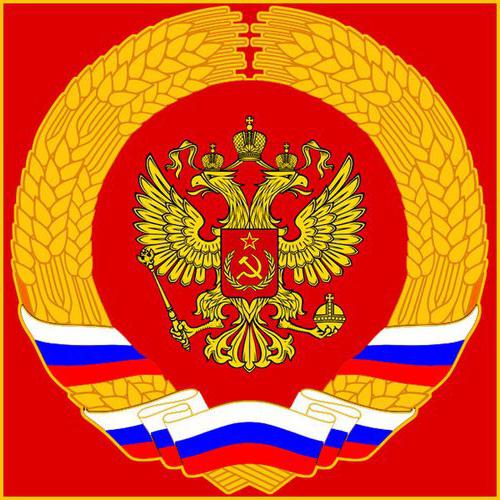
Понятие «республики России»
Области и края считаются административно-территориальными составляющими страны. Республики принято именовать государственными образованиями. Можно сказать, что они представляют собой небольшие народные объединения, существующие на территории одного государства. Все республики России устанавливают собственную конституцию. Кроме того, данные субъекты могут узаконить единый для всей автономии государственный язык. Во времена существования Советского Союза использовалось понятие автономных социалистических республик (сокращенно — АССР), которые также называли автономными областями. Они имели значение национально-государственных образований, тогда как областные центры и края называли единицами территории.
Первые образования
Республики России стали формироваться в начале двадцатого века, едва закончилась революция. Они создавались, выходя из губернских территорий и других единиц. Однако далее такие образования стали возникать из уже существующих областей, имеющих свободное положение. Обычно они считались отдельными территориями, но иногда оставались частью краев и областных центров. Когда в 1936 году была принята Конституция, новые республики стали появляться все реже. Немногие из появившихся ранее полностью отделились России, оставшись, однако, в составе СССР.
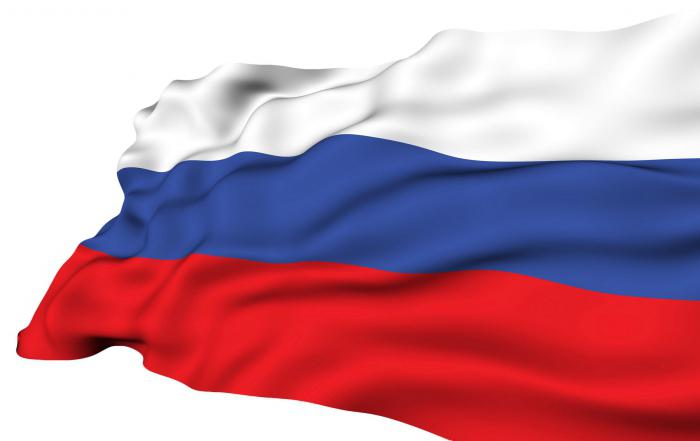
Формирования, входящие в состав других субъектов
Существовали не только республики России. Они формировались и в составе уже отделившихся образований, представляя собой автономные единицы. Например, из советской республики Грузии выделились самостоятельные субъекты — Аджаристан и Абхазия. А в Азербайджанской республике образовалась Нахичеванская. В течение пяти лет в состав Узбекской ССР входило автономное формирование Таджикистан. Позже оно окончательно приобрело полную самостоятельность и стало Таджикской ССР, также заключив союз с некогда покровительствовавшей республикой. Несколько лет спустя Узбекистан получил в свои владения Каракалпакскую АССР. К территории Украины ранее примыкала республика Молдавия, которая покинула ее после двадцати шести лет союза, оставив часть территорий. Последней образовавшейся республикой стала Тувинская. После ее появления количество автономных субъектов не менялось еще тридцать лет.
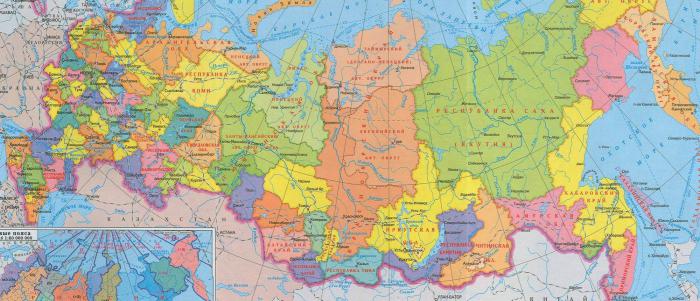
Дальнейшее развитие
Начиная с 1990 года снова стали формироваться республики России (список будет приведен чуть ниже). Однако теперь образование происходило за счет приобретения бывшими автономными субъектами и областями абсолютного суверенитета. Летом 1990-го самостоятельности добилась каждая республика, а также многие области, ранее не имевшие автономии. Произошло преобразование Адыгейской, Хакасской, Горно-Алтайской и, кроме них, Карачаево-Черкесской областей. Затем разделились Чечня и Ингушетия, которые некогда представляли собой объединенную республику. Во время процедуры приобретения субъектами независимости им присуждалось звание суверенных.
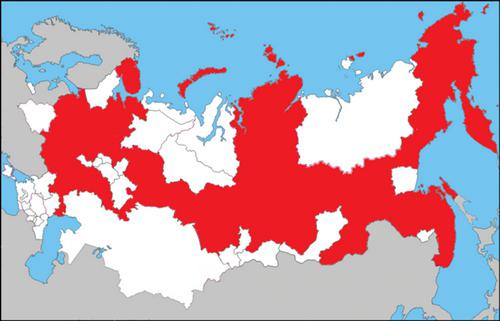 Однако стоит заметить, что за все время не упоминалась тема получения республиками полной автономии и отделения от российских территорий. После получения самостоятельности новые объекты развивались по-разному. Например, едва сформированные республики Аджария и Нахичеванская, которые много лет носили статус автономий, объединились с другими субъектами. Так, они стали частью Грузинского и Азербайджанского образований. Абхазия, являвшаяся советской республикой, планировала остаться частью союза суверенных государств, тогда как Грузия не поддержала эту идею. Сходная проблема возникла у левобережья Днестра, ранее считавшегося частью Молдавской автономии, а затем решившего стать независимой территорией. Мирного решения проблемы не нашлось, поэтому начался ряд боевых действий. Они не помогли Грузии и Молдавии вернуть контроль, лишь поспособствовали ускорению формирования двух новых республик – Абхазии и Приднестровья.
Однако стоит заметить, что за все время не упоминалась тема получения республиками полной автономии и отделения от российских территорий. После получения самостоятельности новые объекты развивались по-разному. Например, едва сформированные республики Аджария и Нахичеванская, которые много лет носили статус автономий, объединились с другими субъектами. Так, они стали частью Грузинского и Азербайджанского образований. Абхазия, являвшаяся советской республикой, планировала остаться частью союза суверенных государств, тогда как Грузия не поддержала эту идею. Сходная проблема возникла у левобережья Днестра, ранее считавшегося частью Молдавской автономии, а затем решившего стать независимой территорией. Мирного решения проблемы не нашлось, поэтому начался ряд боевых действий. Они не помогли Грузии и Молдавии вернуть контроль, лишь поспособствовали ускорению формирования двух новых республик – Абхазии и Приднестровья. 
Перечень
Известны двадцать два автономных образования. Как правило, во всех источниках распределены республики России в алфавитном порядке. Так, в списке обозначены:
- Республика Адыгея;
- Алтай;
- Башкортостан;
- Бурятия;
- Дагестан;
- Ингушетия;
- Кабардино-Балкарская Республика;
- Калмыкия;
- Карачаево-Черкесская Республика;
- Карелия;
- Коми;
- Республика Крым;
- Марий Эл;
- Мордовия;
- Саха (Якутия);
- Северная Осетия — Алания;
- Татарстан;
- Республика Тыва;
- Удмуртская Республика;
- Хакасия;
- Чеченская Республика;
- Чувашская.
Чувашская республика
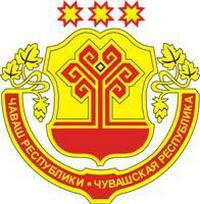 Субъект находится в долине Волги. На правом берегу расположена Приволжская возвышенность, а на левом – равнинная территория. В этой части Волга принимает притоки Сура, Аниш и Цивиль. Во 2 тысячелетии до нашей эры на месте нынешней республики проживали представители балановской и срубной народностей. Через несколько столетий их сменили городецкие племена. Активное заселение началось в 7–9 веках нашей эры. С Нижнего Поволжья в то время переселились племена сувар и болгар. Впоследствии именно из этих народностей образовались чуваши. К 10-13 векам была сформирована Волжская Болгария. Но к 14 столетию государство пришло в упадок. Это было связано с набегами татаро-монголов. Так, в течение нескольких веков земли переходили то болгарам, то монголо-татарам, то примыкали к Казанскому ханству (в 1546 году территория будущей Чувашии оказалась под его игом). В результате народ попросил помощи у царствовавшего тогда Ивана Грозного. В шестнадцатом веке их присоединила к себе Россия. Чувашская республика имела на своей территории несколько крепостей. Среди них такие, например, как Ядрин, Цивильск.
Субъект находится в долине Волги. На правом берегу расположена Приволжская возвышенность, а на левом – равнинная территория. В этой части Волга принимает притоки Сура, Аниш и Цивиль. Во 2 тысячелетии до нашей эры на месте нынешней республики проживали представители балановской и срубной народностей. Через несколько столетий их сменили городецкие племена. Активное заселение началось в 7–9 веках нашей эры. С Нижнего Поволжья в то время переселились племена сувар и болгар. Впоследствии именно из этих народностей образовались чуваши. К 10-13 векам была сформирована Волжская Болгария. Но к 14 столетию государство пришло в упадок. Это было связано с набегами татаро-монголов. Так, в течение нескольких веков земли переходили то болгарам, то монголо-татарам, то примыкали к Казанскому ханству (в 1546 году территория будущей Чувашии оказалась под его игом). В результате народ попросил помощи у царствовавшего тогда Ивана Грозного. В шестнадцатом веке их присоединила к себе Россия. Чувашская республика имела на своей территории несколько крепостей. Среди них такие, например, как Ядрин, Цивильск.fb.ru
| 1 | Республика Адыгея (Адыгея) |
| 2 | Республика Башкортостан |
| 3 | Республика Бурятия |
| 4 | Республика Алтай |
| 5 | Республика Дагестан |
| 6 | Республика Ингушетия |
| 7 | Кабардино-Балкарская Республика |
| 8 | Республика Калмыкия |
| 9 | Карачаево-Черкесская Республика |
| 10 | Республика Карелия |
| 11 | Республика Коми |
| 12 | Республика Марий Эл |
| 13 | Республика Мордовия |
| 14 | Республика Саха (Якутия) |
| 15 | Республика Северная Осетия — Алания |
| 16 | Республика Татарстан (Татарстан) |
| 17 | Республика Тыва |
| 18 | Удмуртская Республика |
| 19 | Республика Хакасия |
| 20 | Чеченская Республика |
| 21 | Чувашская Республика — Чувашия |
| 22 | Алтайский край |
| 23 | Краснодарский край |
| 24 | Красноярский край |
| 25 | Приморский край |
| 26 | Ставропольский край |
| 27 | Хабаровский край |
| 28 | Амурская область |
| 29 | Архангельская область |
| 30 | Астраханская область |
| 31 | Белгородская область |
| 32 | Брянская область |
| 33 | Владимирская область |
| 34 | Волгоградская область |
| 35 | Вологодская область |
| 36 | Воронежская область |
| 37 | Ивановская область |
| 38 | Иркутская область |
| 39 | Калининградская область |
| 40 | Калужская область |
| 41 | Камчатский край |
| 42 | Кемеровская область |
| 43 | Кировская область |
| 44 | Костромская область |
| 45 | Курганская область |
| 46 | Курская область |
| 47 | Ленинградская область |
| 48 | Липецкая область |
| 49 | Магаданская область |
| 50 | Московская область |
| 51 | Мурманская область |
| 52 | Нижегородская область |
| 53 | Новгородская область |
| 54 | Новосибирская область |
| 55 | Омская область |
| 56 | Оренбургская область |
| 57 | Орловская область |
| 58 | Пензенская область |
| 59 | Пермский край |
| 60 | Псковская область |
| 61 | Ростовская область |
| 62 | Рязанская область |
| 63 | Самарская область |
| 64 | Саратовская область |
| 65 | Сахалинская область |
| 66 | Свердловская область |
| 67 | Смоленская область |
| 68 | Тамбовская область |
| 69 | Тверская область |
| 70 | Томская область |
| 71 | Тульская область |
| 72 | Тюменская область |
| 73 | Ульяновская область |
| 74 | Челябинская область |
| 75 | Забайкальский край |
| 76 | Ярославская область |
| 77 | г. Москва |
| 78 | Санкт-Петербург |
| 79 | Еврейская автономная область |
| 83 | Ненецкий автономный округ |
| 86 | Ханты-Мансийский автономный округ — Югра |
| 87 | Чукотский автономный округ |
| 89 | Ямало-Ненецкий автономный округ |
| 91 | Республика Крым |
| 92 | Севастополь |
| 99 | Иные территории, включая город и космодром Байконур |
www.statdata.ru
